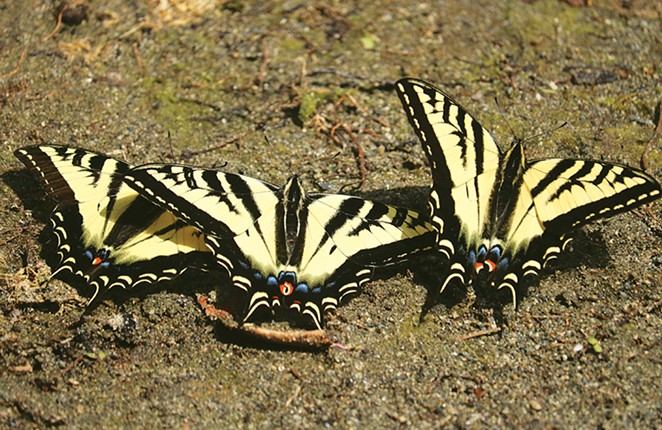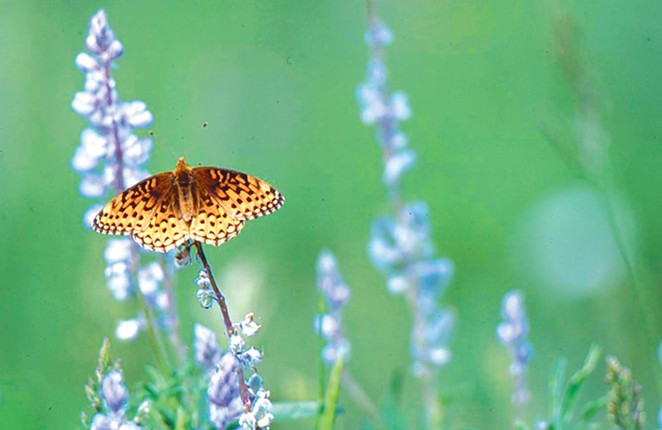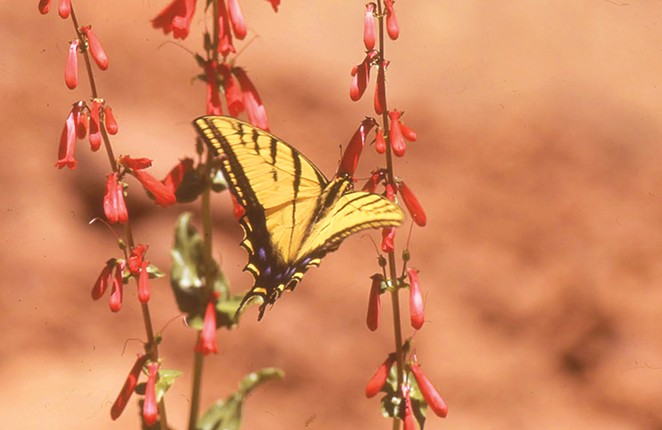Summer is the season when butterflies flit and flutter through wildflower meadows or neighborhood gardens.
To the ancient Greeks and Romans, butterflies were the symbolic representation of the human soul. British broadcaster and longtime naturalist Sir David Attenborough claimed that watching butterflies is good for our mental health. No matter the appeal, butterflies serve important roles in the ecosystem as pollinators and prey but are also just a joy to watch.
So, if you're interested in watching butterflies, a passtime called "butterflying," there are numerous locations across Central Oregon to encounter these engaging creatures, including Deschutes Land Trust preserves.
"My two favorite Land Trust preserves for butterflying are the Metolius Preserve, specifically the North Trailhead Larch trails and Whychus Canyon Preserve, Rim and Creek trails," said Amanda Egertson, Deschutes Land Trust stewardship director. The northern section of the Metolius Preserve has a lot of plant diversity, which in turn, attracts a variety of butterflies. "To date, we've observed over 50 species of butterflies there!"
Egertson also likes butterflying at the Whychus Canyon Preserve for a different reason. "Every year in July, there are lots of my favorite Central Oregon butterfly flitting about, the Melissa's blue." These butterflies have a wing span about 1-1½" wide. Males are strikingly blue with a dark border on the uppersides, and females are browner with a blue tinge on the upper wings. Their caterpillars feed on lupines, a host plant, and are often attended to by ants, which feed on the caterpillar secretions, like the honeydew provided by aphids, and protect against predators of the hungry caterpillars.
Egertson's list of butterflies which are likely to be observed in the region include red admirals, California tortoiseshells, Mourning cloaks, Echo azures, Juniper hairstreaks and Western tiger swallowtails. "There are well over 100," said Egertson, so the list is pretty good.
Buddy Mays, a Bend-based photographer and the author of "The Butterflies of Central Oregon," also believes the Western tiger swallowtail and the Pale swallowtail are two butterflies which represent the area. "They are two of the earliest appearing butterflies in the area, and one of the longest lasting, still being seen into October," said Mays. These large, yellowish butterflies seem to float in the air as they flit and dip through the summer sky.
Though monarch butterflies get a lot of love in Central Oregon, Mays says that the swallowtails aren't as picky about their host plants as monarchs are. "Monarch caterpillars feed on milkweeds, and there isn't much milkweed in Central Oregon," said Mays. "Swallowtail caterpillars will eat a variety of plants, including the leaves of cottonwood, willow, aspen, alder, maple and ash trees — all of which are common in our area."
As pollinators, butterflies have a remarkable ability to detect food. "Strangely enough, their taste buds are located on their feet and legs and are tiny chemoreceptors that detect the molecules of edible food plants," said Mays. Butterflies lack a mouth, tongue or taste buds. "To eat, they use their proboscis, a long hollow feeding tube, through which they suck up nectar and pollen from the flowers," added Mays.
In order to provide adequate nectar for swallowtails, monarchs and other butterflies, the DLT recommends planting a variety of native plants in one's garden to attract these summer flutterbys and other pollinators. "We encourage folks to plant showy or narrowleaf milkweed – the host plant for our migrating Western monarchs, whose populations are in severe decline, and nectar plants for many pollinators," said Egertson. "Beyond that, we encourage folks to plant a variety of native pollinator-friendly plants that provide staggered bloom times from spring through fall, so pollinators have the resources they need whenever they pass through."
If photographing butterflies is an interest, Mays recommends finding a suitable area, such as the Metolius Preserve, with an active butterfly population and using a telephoto lens. "Use a high shutter speed, at least 1/500 of a second, to freeze the butterfly's motion," said Mays. "Most wild butterflies don't object to reasonably close contact with humans as long as the they're not acting aggressive. Keep low so as to not become a large, hulking, scary object that will simply frighten away your subject."
To learn more about butterflies, Egertson and volunteer, Sue Anderson, lead butterfly walks for the DLT. Several are scheduled for June 14, 23, and 30, with a couple of them geared towards kids. In summer, the North American Butterfly Association organizes a census called the Butterfly Count, which is another great opportunity to learn about these flying jewels of summer.

























